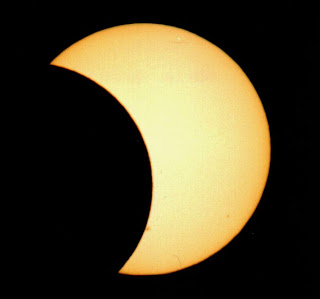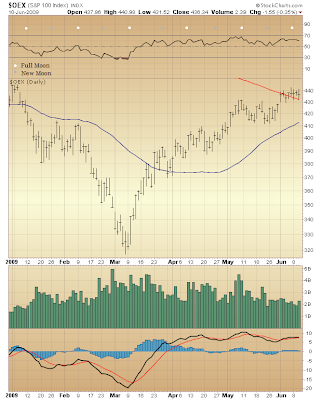 Here's something you might want to keep on the radar...
Here's something you might want to keep on the radar...Several years back, a cycle watcher named Steve Puetz attempted to see if eclipses and market crashes were somehow related. He studied eight of the greatest crashes in financial history, from the Holland Tulip Mania of 1637 to the Nikkei of 1990. He found that market crashes tend to occur near full moons, and that the greatest number of crashes start after the first full moon after a solar eclipse, when that full moon is also a lunar eclipse.
Puetz found that all eight crashes occurred six days before to three days after a full moon that occurred within six weeks of a solar eclipse. The odds of that being a coincidence, Puetz calculated, are less than 1 in 127,000.
Believe it or not, the crashes of 1987 and 1929 were immediately preceded by a solar eclipse which was then followed by a full moon/lunar eclipse at the time of the crash or close thereby.
So, check this out...
Lunar Eclipse: July 7, 2009
Solar Eclipse: July 22, 2009
Lunar Eclipse: August 6, 2009
Trust me, like all things of a cyclical nature this is only a curiosity ... simply something to keep an eye on. However, the fact that July's solar eclipse is both preceded and followed by a lunar eclipse is rather unusual, so I wanted to bring this to your attention. I probably will not make much mention of it again over coming weeks.
Whether lunar and solar cycles can affect individual or mass psychology is a subject that has been debated for centuries. Stock traders have long had a saying, "Sell the full moon, buy the new," and it is remarkable how often new and full moons can mark a turn in the market within a day or two...

Remarkable indeed! Again, though, this is an interesting curiosity and nothing more.
Sunday, June 7th, brought the most recent full moon. Monday, June 22nd — the first day of trading following "triple witching" expiration on June 19th — brings the next new moon.
Tuck it away. Tomorrow we'll get back to beating the dead horse that is all things technical demonstrating the market's growing underlying weakness.
Now, just for grins I marked up a 2008 chart showing when both a new moon and full moon occurred during last year's disaster. A solar eclipse on August 1, 2008 and a lunar eclipse immediately following on August 15th also are shown...

Duly note last October's collapse does not fit the criteria Steve Puetz reported. Yet the proximity of the Lehman Brothers collapse and subsequent broad market decline are reasonably close to the "window" Puetz's study lays out.
We saw something similar to this in 2002...

Depending whether the decline over the summer of 2002 qualifies as a "crash," you might conclude Steve Puetz's "window" at least saw pronounced selling (to be honest there was nothing 1987- or 1929-like that developed over the course of the market's 2002 decline).
So, that's that. I really hesitate to make much of anything about this, because it comes a lot closer to a consultation with Miss Cleo than I am generally comfortable with. However the empirical evidence has been reported by Puetz, so for what it is worth there you have it.
Remember: only 1 in 100-200 solar/lunar eclipse sequences coincides with a crash event. I present Steve Puetz's findings here only because Elliott Wave possibilities suggest this next eclipse sequence could, indeed, be significant.
Per the effect of the sun and the moon on mass behavior ... well, all I know is that only 500 years ago mankind determined the truth about the cosmos. Prior to the Golden Renaissance common knowledge held that the earth was at the center of the universe.
Indeed, such relatively recent developments as brought better understanding of the working of the solar system are why I believe mankind has barely scratched the surface of discoveries that could radically improve life...

* * * * *
© The Risk Averse Alert — Advocating a patient, disciplined approach to stock market investing. Overriding objective is limiting financial risk. Minimizing investment capital loss is a priority.
Analysis centers on the stock market's path of least resistance. Long-term, this drives a simple strategy for safely investing a 401(k) for maximum profit. Intermediate-term, investing with stock index tracking-ETFs (both their long and short varieties) is advanced. Short-term, stock index options occasionally offer extraordinary profit opportunities when the stock market is moving along its projected path.
Nothing is set in stone. Nor is the stock market's path of least resistance always known. More often than not, there are no stock index option positions recommended.
 There's an easy way to boost your investment discipline...
There's an easy way to boost your investment discipline...Get Real-Time Trade Notification!



















